Global Business Cultural Analysis of India and USA Trade
VerifiedAdded on 2023/01/24
|23
|4635
|94
Report
AI Summary
This report provides a detailed analysis of the global business cultural landscape between India and the United States, focusing on the impact of cultural dimensions on international trade. It begins with an introduction to globalization and its effects on business, emphasizing the importance of understanding cultural differences. The core of the report uses Hofstede's cultural dimensions framework to compare the two countries across power distance, individualism, masculinity, uncertainty avoidance, and long-term orientation. The report highlights the similarities and differences in these dimensions and their implications for business practices. A SWOT analysis is then conducted to assess the strengths, weaknesses, opportunities, and threats for US businesses looking to invest in India, considering demographic, cultural, and economic factors. The report concludes by summarizing the key findings and implications for international business strategy.
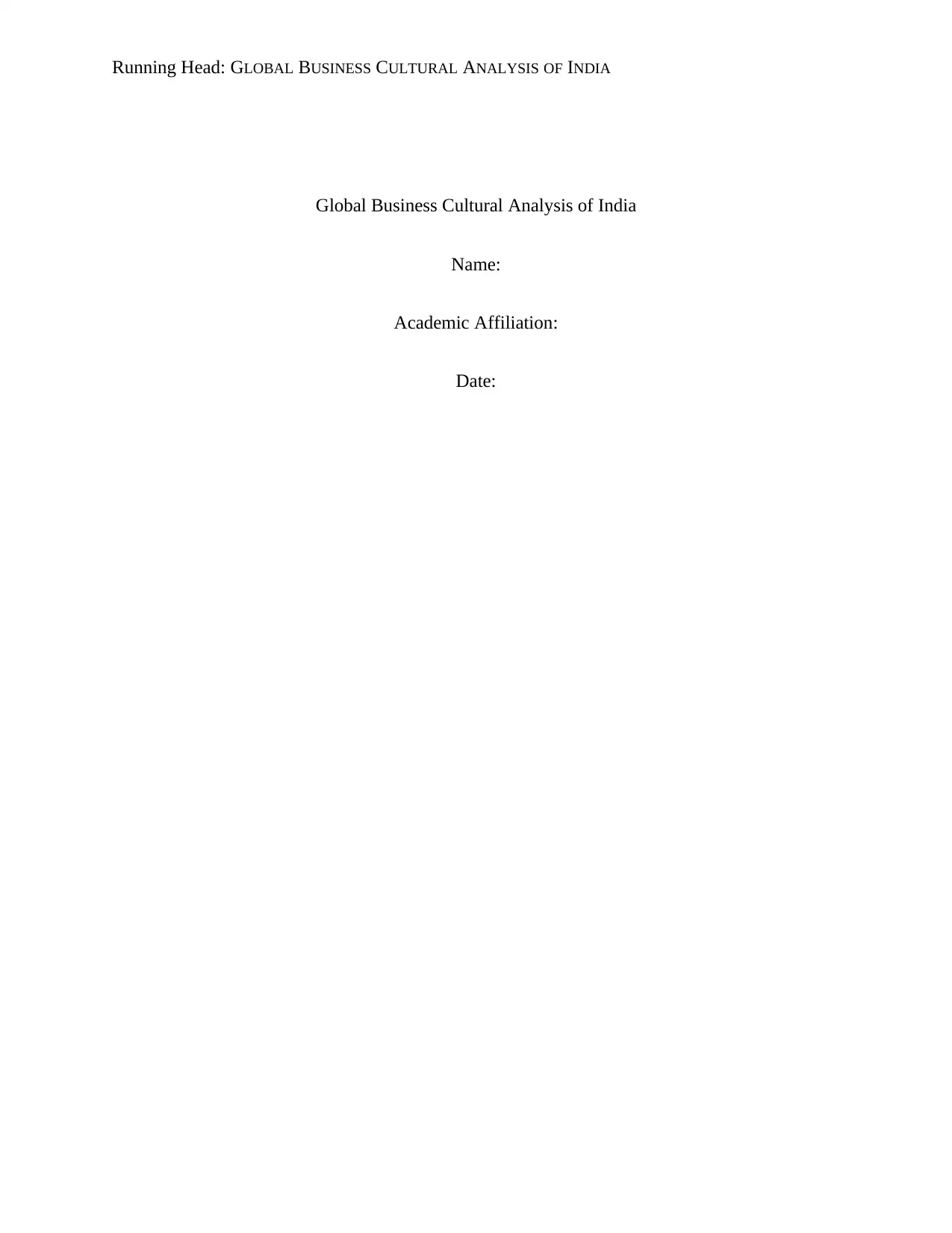
Running Head: GLOBAL BUSINESS CULTURAL ANALYSIS OF INDIA
Global Business Cultural Analysis of India
Name:
Academic Affiliation:
Date:
Global Business Cultural Analysis of India
Name:
Academic Affiliation:
Date:
Paraphrase This Document
Need a fresh take? Get an instant paraphrase of this document with our AI Paraphraser
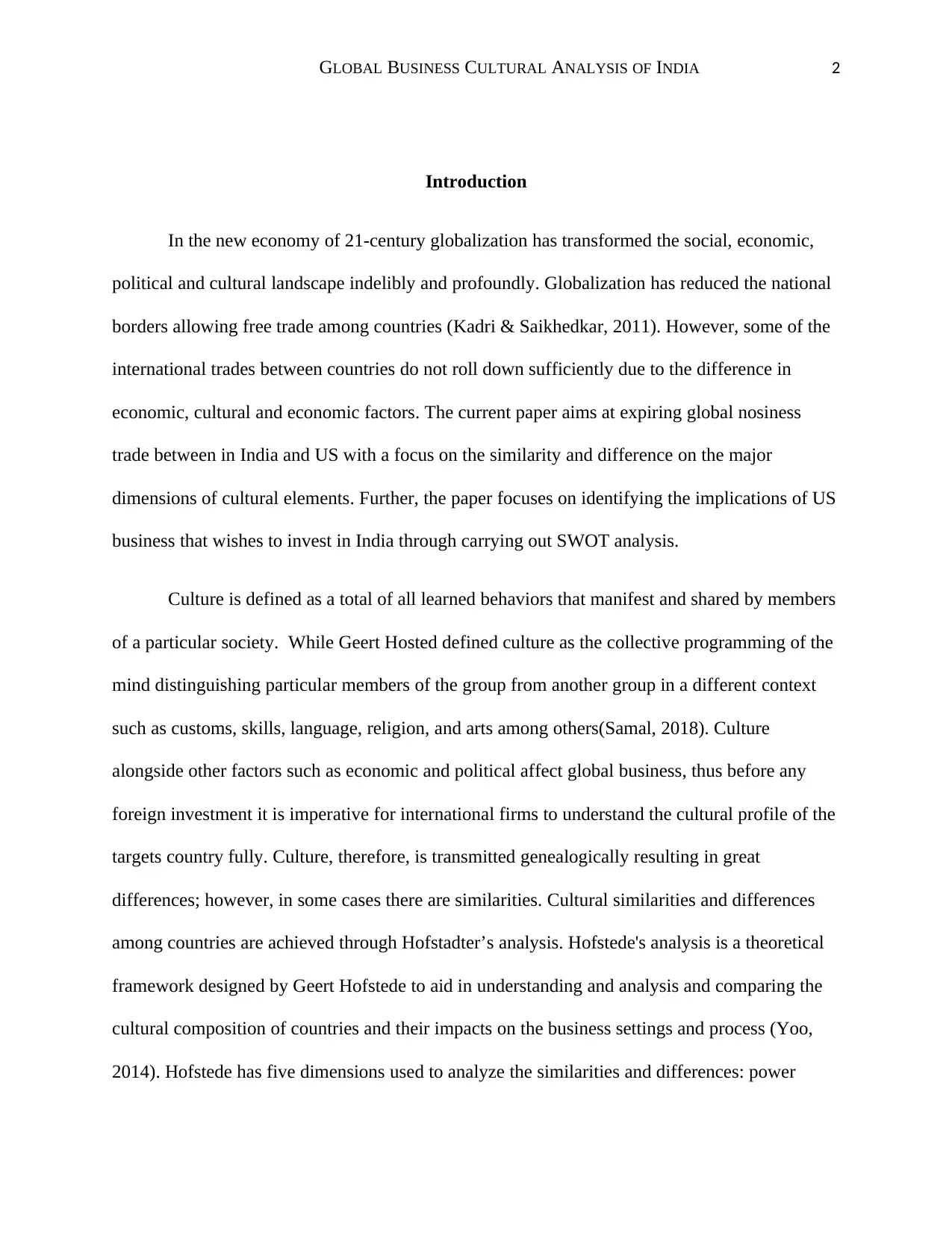
GLOBAL BUSINESS CULTURAL ANALYSIS OF INDIA 2
Introduction
In the new economy of 21-century globalization has transformed the social, economic,
political and cultural landscape indelibly and profoundly. Globalization has reduced the national
borders allowing free trade among countries (Kadri & Saikhedkar, 2011). However, some of the
international trades between countries do not roll down sufficiently due to the difference in
economic, cultural and economic factors. The current paper aims at expiring global nosiness
trade between in India and US with a focus on the similarity and difference on the major
dimensions of cultural elements. Further, the paper focuses on identifying the implications of US
business that wishes to invest in India through carrying out SWOT analysis.
Culture is defined as a total of all learned behaviors that manifest and shared by members
of a particular society. While Geert Hosted defined culture as the collective programming of the
mind distinguishing particular members of the group from another group in a different context
such as customs, skills, language, religion, and arts among others(Samal, 2018). Culture
alongside other factors such as economic and political affect global business, thus before any
foreign investment it is imperative for international firms to understand the cultural profile of the
targets country fully. Culture, therefore, is transmitted genealogically resulting in great
differences; however, in some cases there are similarities. Cultural similarities and differences
among countries are achieved through Hofstadter’s analysis. Hofstede's analysis is a theoretical
framework designed by Geert Hofstede to aid in understanding and analysis and comparing the
cultural composition of countries and their impacts on the business settings and process (Yoo,
2014). Hofstede has five dimensions used to analyze the similarities and differences: power
Introduction
In the new economy of 21-century globalization has transformed the social, economic,
political and cultural landscape indelibly and profoundly. Globalization has reduced the national
borders allowing free trade among countries (Kadri & Saikhedkar, 2011). However, some of the
international trades between countries do not roll down sufficiently due to the difference in
economic, cultural and economic factors. The current paper aims at expiring global nosiness
trade between in India and US with a focus on the similarity and difference on the major
dimensions of cultural elements. Further, the paper focuses on identifying the implications of US
business that wishes to invest in India through carrying out SWOT analysis.
Culture is defined as a total of all learned behaviors that manifest and shared by members
of a particular society. While Geert Hosted defined culture as the collective programming of the
mind distinguishing particular members of the group from another group in a different context
such as customs, skills, language, religion, and arts among others(Samal, 2018). Culture
alongside other factors such as economic and political affect global business, thus before any
foreign investment it is imperative for international firms to understand the cultural profile of the
targets country fully. Culture, therefore, is transmitted genealogically resulting in great
differences; however, in some cases there are similarities. Cultural similarities and differences
among countries are achieved through Hofstadter’s analysis. Hofstede's analysis is a theoretical
framework designed by Geert Hofstede to aid in understanding and analysis and comparing the
cultural composition of countries and their impacts on the business settings and process (Yoo,
2014). Hofstede has five dimensions used to analyze the similarities and differences: power
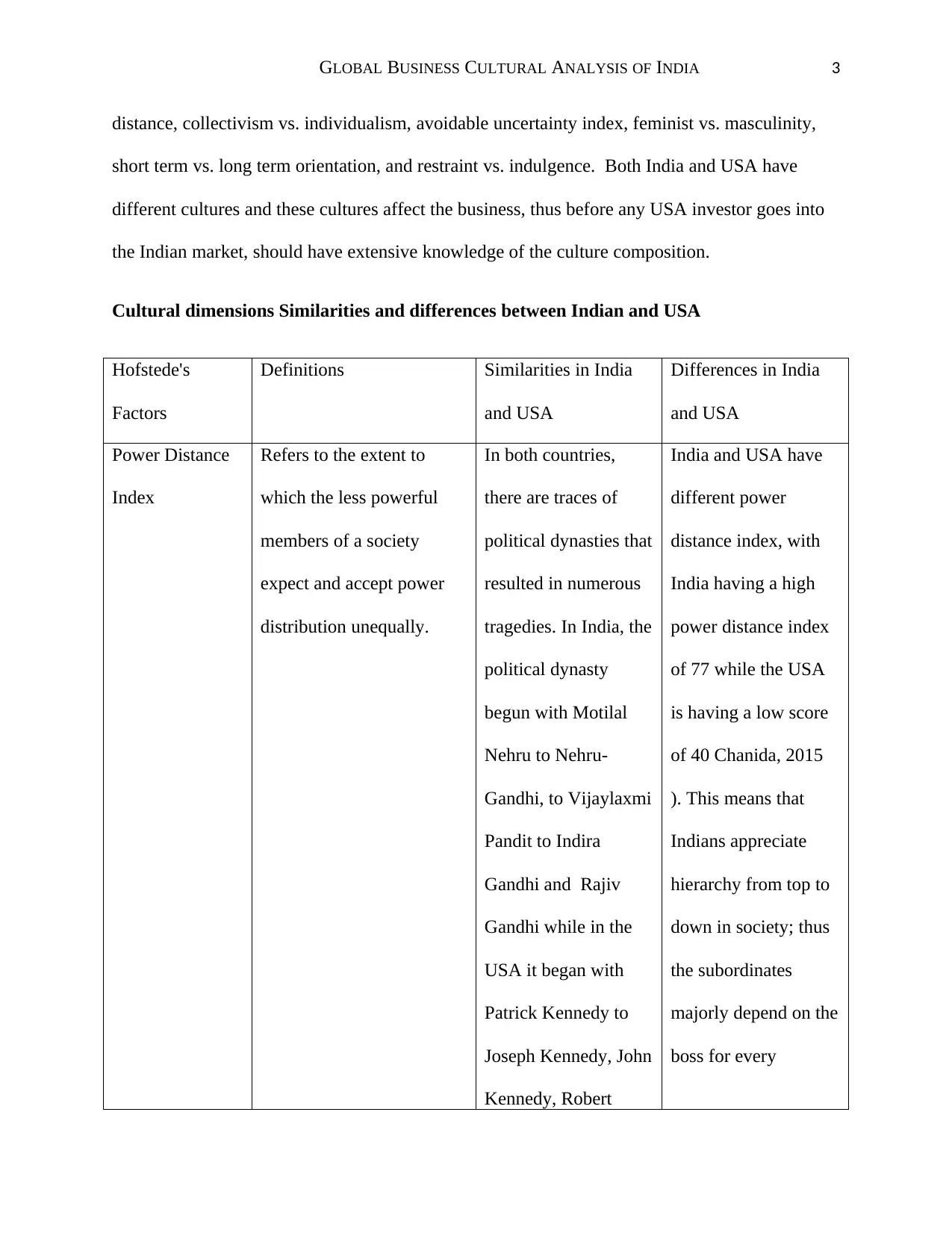
GLOBAL BUSINESS CULTURAL ANALYSIS OF INDIA 3
distance, collectivism vs. individualism, avoidable uncertainty index, feminist vs. masculinity,
short term vs. long term orientation, and restraint vs. indulgence. Both India and USA have
different cultures and these cultures affect the business, thus before any USA investor goes into
the Indian market, should have extensive knowledge of the culture composition.
Cultural dimensions Similarities and differences between Indian and USA
Hofstede's
Factors
Definitions Similarities in India
and USA
Differences in India
and USA
Power Distance
Index
Refers to the extent to
which the less powerful
members of a society
expect and accept power
distribution unequally.
In both countries,
there are traces of
political dynasties that
resulted in numerous
tragedies. In India, the
political dynasty
begun with Motilal
Nehru to Nehru-
Gandhi, to Vijaylaxmi
Pandit to Indira
Gandhi and Rajiv
Gandhi while in the
USA it began with
Patrick Kennedy to
Joseph Kennedy, John
Kennedy, Robert
India and USA have
different power
distance index, with
India having a high
power distance index
of 77 while the USA
is having a low score
of 40 Chanida, 2015
). This means that
Indians appreciate
hierarchy from top to
down in society; thus
the subordinates
majorly depend on the
boss for every
distance, collectivism vs. individualism, avoidable uncertainty index, feminist vs. masculinity,
short term vs. long term orientation, and restraint vs. indulgence. Both India and USA have
different cultures and these cultures affect the business, thus before any USA investor goes into
the Indian market, should have extensive knowledge of the culture composition.
Cultural dimensions Similarities and differences between Indian and USA
Hofstede's
Factors
Definitions Similarities in India
and USA
Differences in India
and USA
Power Distance
Index
Refers to the extent to
which the less powerful
members of a society
expect and accept power
distribution unequally.
In both countries,
there are traces of
political dynasties that
resulted in numerous
tragedies. In India, the
political dynasty
begun with Motilal
Nehru to Nehru-
Gandhi, to Vijaylaxmi
Pandit to Indira
Gandhi and Rajiv
Gandhi while in the
USA it began with
Patrick Kennedy to
Joseph Kennedy, John
Kennedy, Robert
India and USA have
different power
distance index, with
India having a high
power distance index
of 77 while the USA
is having a low score
of 40 Chanida, 2015
). This means that
Indians appreciate
hierarchy from top to
down in society; thus
the subordinates
majorly depend on the
boss for every
⊘ This is a preview!⊘
Do you want full access?
Subscribe today to unlock all pages.

Trusted by 1+ million students worldwide
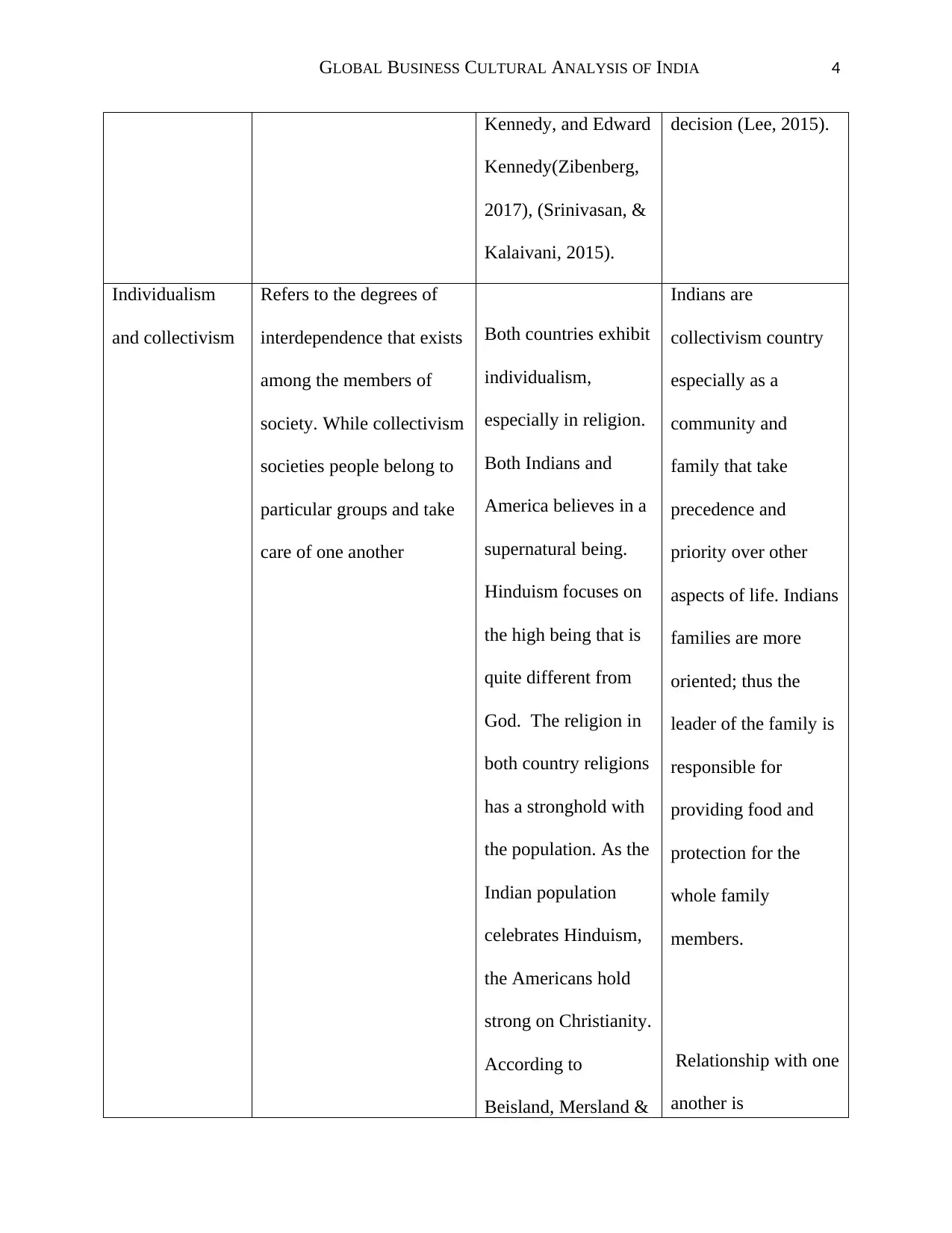
GLOBAL BUSINESS CULTURAL ANALYSIS OF INDIA 4
Kennedy, and Edward
Kennedy(Zibenberg,
2017), (Srinivasan, &
Kalaivani, 2015).
decision (Lee, 2015).
Individualism
and collectivism
Refers to the degrees of
interdependence that exists
among the members of
society. While collectivism
societies people belong to
particular groups and take
care of one another
Both countries exhibit
individualism,
especially in religion.
Both Indians and
America believes in a
supernatural being.
Hinduism focuses on
the high being that is
quite different from
God. The religion in
both country religions
has a stronghold with
the population. As the
Indian population
celebrates Hinduism,
the Americans hold
strong on Christianity.
According to
Beisland, Mersland &
Indians are
collectivism country
especially as a
community and
family that take
precedence and
priority over other
aspects of life. Indians
families are more
oriented; thus the
leader of the family is
responsible for
providing food and
protection for the
whole family
members.
Relationship with one
another is
Kennedy, and Edward
Kennedy(Zibenberg,
2017), (Srinivasan, &
Kalaivani, 2015).
decision (Lee, 2015).
Individualism
and collectivism
Refers to the degrees of
interdependence that exists
among the members of
society. While collectivism
societies people belong to
particular groups and take
care of one another
Both countries exhibit
individualism,
especially in religion.
Both Indians and
America believes in a
supernatural being.
Hinduism focuses on
the high being that is
quite different from
God. The religion in
both country religions
has a stronghold with
the population. As the
Indian population
celebrates Hinduism,
the Americans hold
strong on Christianity.
According to
Beisland, Mersland &
Indians are
collectivism country
especially as a
community and
family that take
precedence and
priority over other
aspects of life. Indians
families are more
oriented; thus the
leader of the family is
responsible for
providing food and
protection for the
whole family
members.
Relationship with one
another is
Paraphrase This Document
Need a fresh take? Get an instant paraphrase of this document with our AI Paraphraser
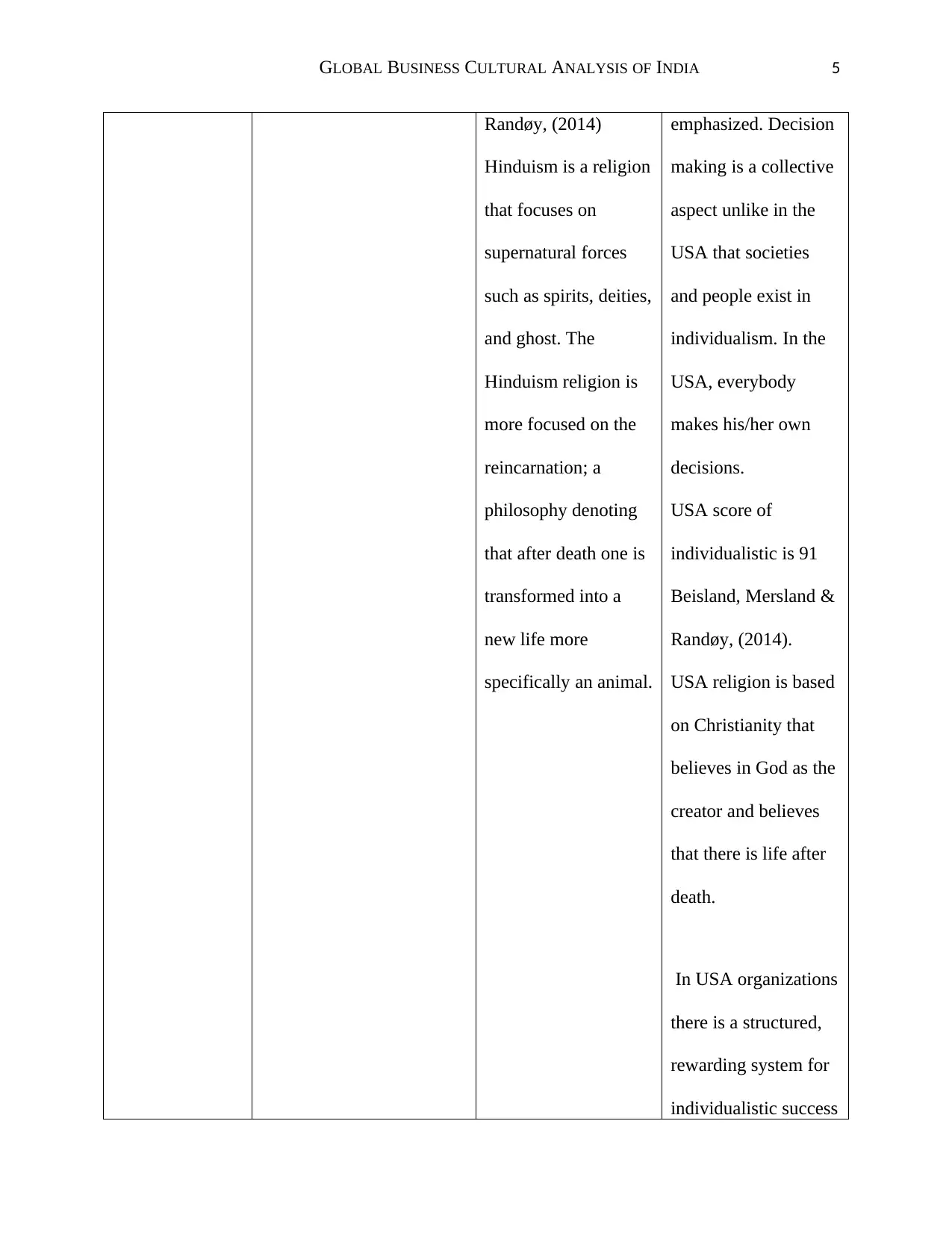
GLOBAL BUSINESS CULTURAL ANALYSIS OF INDIA 5
Randøy, (2014)
Hinduism is a religion
that focuses on
supernatural forces
such as spirits, deities,
and ghost. The
Hinduism religion is
more focused on the
reincarnation; a
philosophy denoting
that after death one is
transformed into a
new life more
specifically an animal.
emphasized. Decision
making is a collective
aspect unlike in the
USA that societies
and people exist in
individualism. In the
USA, everybody
makes his/her own
decisions.
USA score of
individualistic is 91
Beisland, Mersland &
Randøy, (2014).
USA religion is based
on Christianity that
believes in God as the
creator and believes
that there is life after
death.
In USA organizations
there is a structured,
rewarding system for
individualistic success
Randøy, (2014)
Hinduism is a religion
that focuses on
supernatural forces
such as spirits, deities,
and ghost. The
Hinduism religion is
more focused on the
reincarnation; a
philosophy denoting
that after death one is
transformed into a
new life more
specifically an animal.
emphasized. Decision
making is a collective
aspect unlike in the
USA that societies
and people exist in
individualism. In the
USA, everybody
makes his/her own
decisions.
USA score of
individualistic is 91
Beisland, Mersland &
Randøy, (2014).
USA religion is based
on Christianity that
believes in God as the
creator and believes
that there is life after
death.
In USA organizations
there is a structured,
rewarding system for
individualistic success
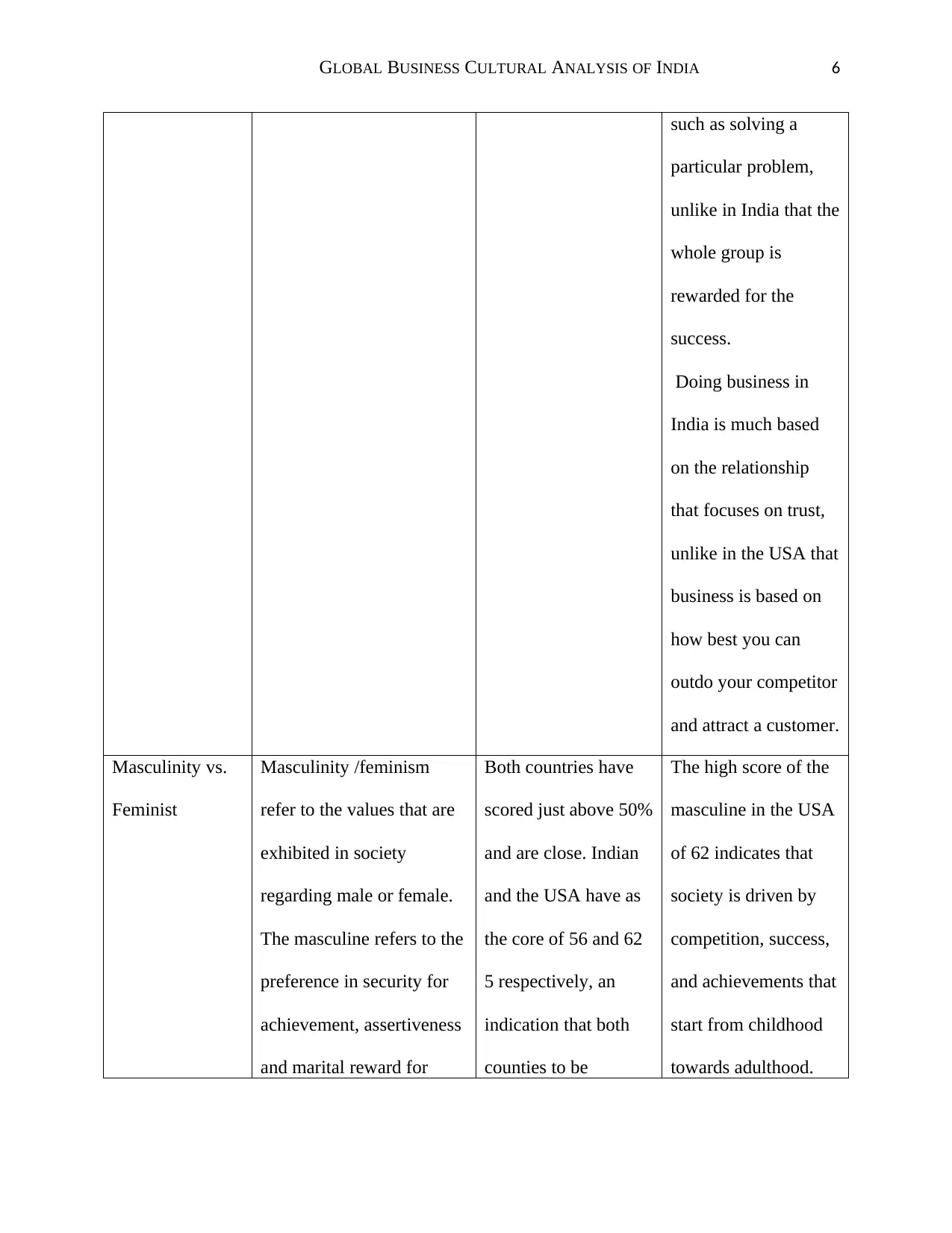
GLOBAL BUSINESS CULTURAL ANALYSIS OF INDIA 6
such as solving a
particular problem,
unlike in India that the
whole group is
rewarded for the
success.
Doing business in
India is much based
on the relationship
that focuses on trust,
unlike in the USA that
business is based on
how best you can
outdo your competitor
and attract a customer.
Masculinity vs.
Feminist
Masculinity /feminism
refer to the values that are
exhibited in society
regarding male or female.
The masculine refers to the
preference in security for
achievement, assertiveness
and marital reward for
Both countries have
scored just above 50%
and are close. Indian
and the USA have as
the core of 56 and 62
5 respectively, an
indication that both
counties to be
The high score of the
masculine in the USA
of 62 indicates that
society is driven by
competition, success,
and achievements that
start from childhood
towards adulthood.
such as solving a
particular problem,
unlike in India that the
whole group is
rewarded for the
success.
Doing business in
India is much based
on the relationship
that focuses on trust,
unlike in the USA that
business is based on
how best you can
outdo your competitor
and attract a customer.
Masculinity vs.
Feminist
Masculinity /feminism
refer to the values that are
exhibited in society
regarding male or female.
The masculine refers to the
preference in security for
achievement, assertiveness
and marital reward for
Both countries have
scored just above 50%
and are close. Indian
and the USA have as
the core of 56 and 62
5 respectively, an
indication that both
counties to be
The high score of the
masculine in the USA
of 62 indicates that
society is driven by
competition, success,
and achievements that
start from childhood
towards adulthood.
⊘ This is a preview!⊘
Do you want full access?
Subscribe today to unlock all pages.

Trusted by 1+ million students worldwide
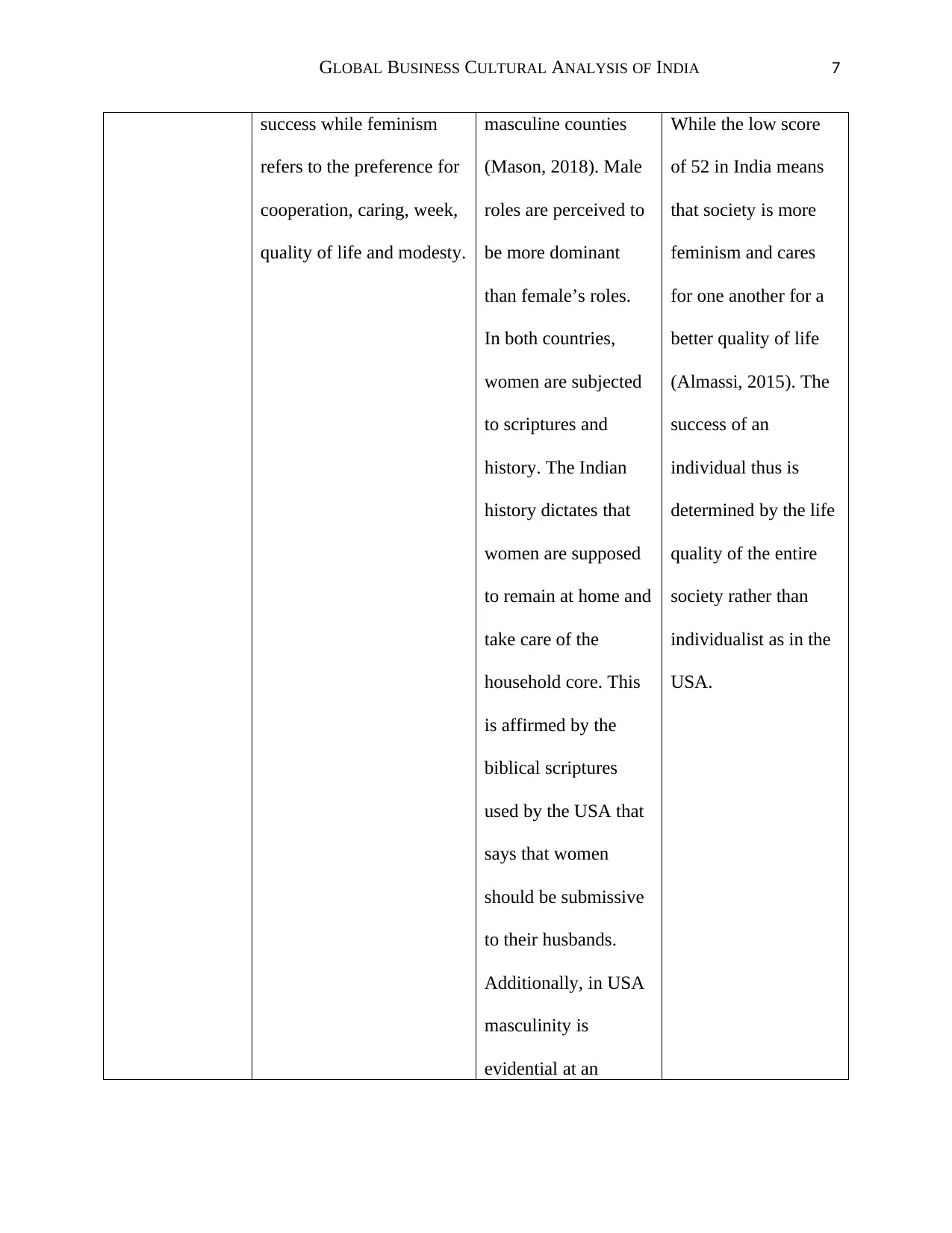
GLOBAL BUSINESS CULTURAL ANALYSIS OF INDIA 7
success while feminism
refers to the preference for
cooperation, caring, week,
quality of life and modesty.
masculine counties
(Mason, 2018). Male
roles are perceived to
be more dominant
than female’s roles.
In both countries,
women are subjected
to scriptures and
history. The Indian
history dictates that
women are supposed
to remain at home and
take care of the
household core. This
is affirmed by the
biblical scriptures
used by the USA that
says that women
should be submissive
to their husbands.
Additionally, in USA
masculinity is
evidential at an
While the low score
of 52 in India means
that society is more
feminism and cares
for one another for a
better quality of life
(Almassi, 2015). The
success of an
individual thus is
determined by the life
quality of the entire
society rather than
individualist as in the
USA.
success while feminism
refers to the preference for
cooperation, caring, week,
quality of life and modesty.
masculine counties
(Mason, 2018). Male
roles are perceived to
be more dominant
than female’s roles.
In both countries,
women are subjected
to scriptures and
history. The Indian
history dictates that
women are supposed
to remain at home and
take care of the
household core. This
is affirmed by the
biblical scriptures
used by the USA that
says that women
should be submissive
to their husbands.
Additionally, in USA
masculinity is
evidential at an
While the low score
of 52 in India means
that society is more
feminism and cares
for one another for a
better quality of life
(Almassi, 2015). The
success of an
individual thus is
determined by the life
quality of the entire
society rather than
individualist as in the
USA.
Paraphrase This Document
Need a fresh take? Get an instant paraphrase of this document with our AI Paraphraser
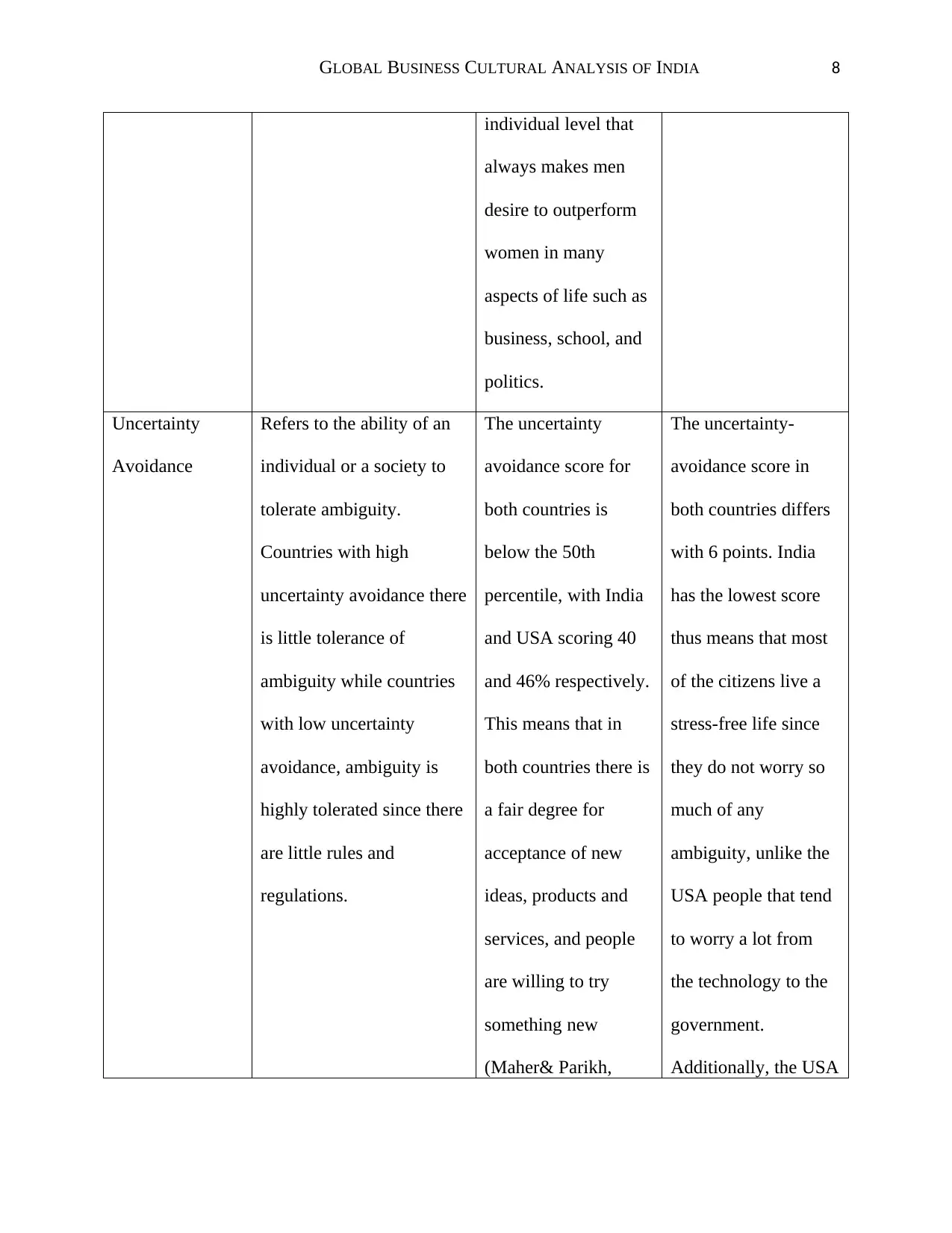
GLOBAL BUSINESS CULTURAL ANALYSIS OF INDIA 8
individual level that
always makes men
desire to outperform
women in many
aspects of life such as
business, school, and
politics.
Uncertainty
Avoidance
Refers to the ability of an
individual or a society to
tolerate ambiguity.
Countries with high
uncertainty avoidance there
is little tolerance of
ambiguity while countries
with low uncertainty
avoidance, ambiguity is
highly tolerated since there
are little rules and
regulations.
The uncertainty
avoidance score for
both countries is
below the 50th
percentile, with India
and USA scoring 40
and 46% respectively.
This means that in
both countries there is
a fair degree for
acceptance of new
ideas, products and
services, and people
are willing to try
something new
(Maher& Parikh,
The uncertainty-
avoidance score in
both countries differs
with 6 points. India
has the lowest score
thus means that most
of the citizens live a
stress-free life since
they do not worry so
much of any
ambiguity, unlike the
USA people that tend
to worry a lot from
the technology to the
government.
Additionally, the USA
individual level that
always makes men
desire to outperform
women in many
aspects of life such as
business, school, and
politics.
Uncertainty
Avoidance
Refers to the ability of an
individual or a society to
tolerate ambiguity.
Countries with high
uncertainty avoidance there
is little tolerance of
ambiguity while countries
with low uncertainty
avoidance, ambiguity is
highly tolerated since there
are little rules and
regulations.
The uncertainty
avoidance score for
both countries is
below the 50th
percentile, with India
and USA scoring 40
and 46% respectively.
This means that in
both countries there is
a fair degree for
acceptance of new
ideas, products and
services, and people
are willing to try
something new
(Maher& Parikh,
The uncertainty-
avoidance score in
both countries differs
with 6 points. India
has the lowest score
thus means that most
of the citizens live a
stress-free life since
they do not worry so
much of any
ambiguity, unlike the
USA people that tend
to worry a lot from
the technology to the
government.
Additionally, the USA
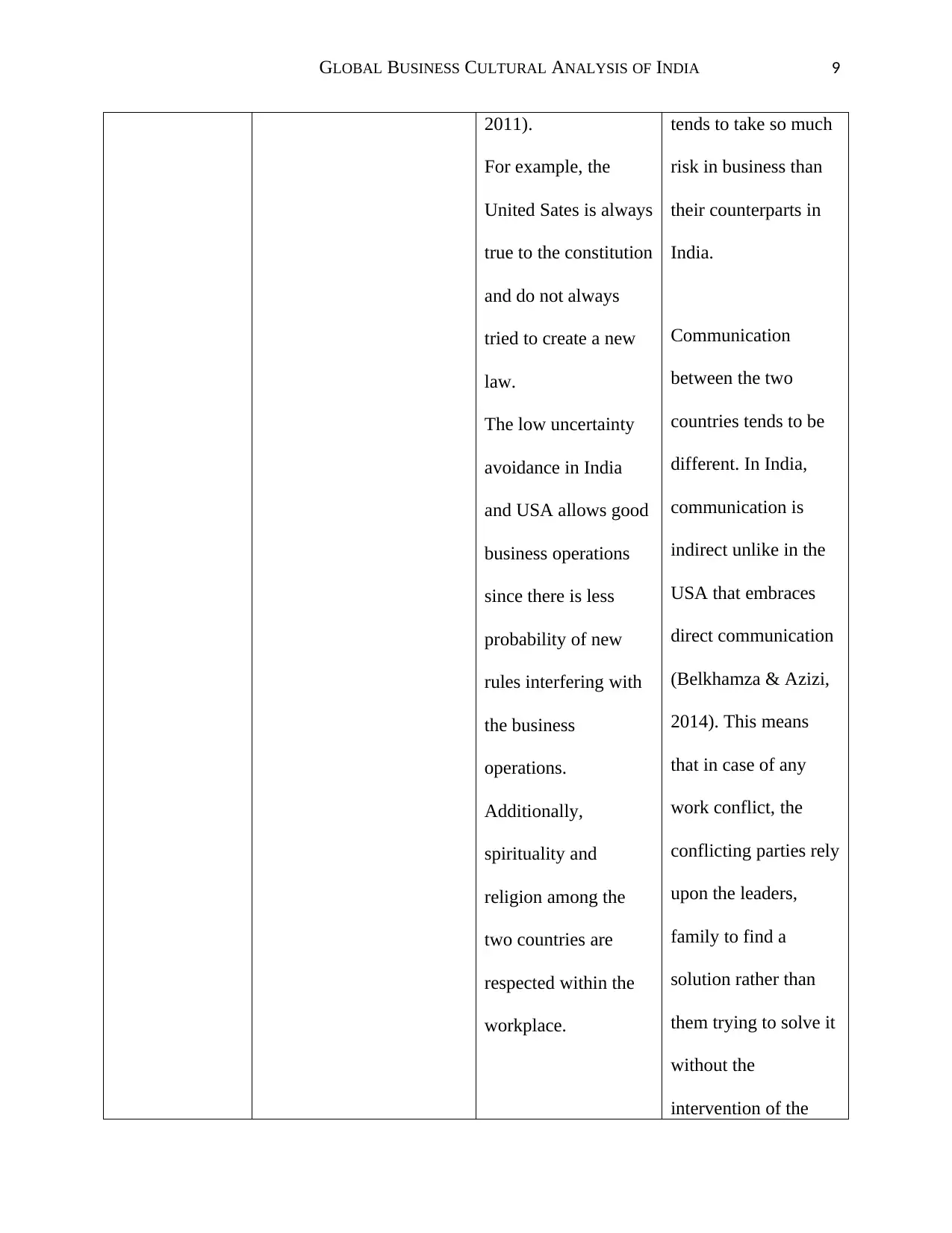
GLOBAL BUSINESS CULTURAL ANALYSIS OF INDIA 9
2011).
For example, the
United Sates is always
true to the constitution
and do not always
tried to create a new
law.
The low uncertainty
avoidance in India
and USA allows good
business operations
since there is less
probability of new
rules interfering with
the business
operations.
Additionally,
spirituality and
religion among the
two countries are
respected within the
workplace.
tends to take so much
risk in business than
their counterparts in
India.
Communication
between the two
countries tends to be
different. In India,
communication is
indirect unlike in the
USA that embraces
direct communication
(Belkhamza & Azizi,
2014). This means
that in case of any
work conflict, the
conflicting parties rely
upon the leaders,
family to find a
solution rather than
them trying to solve it
without the
intervention of the
2011).
For example, the
United Sates is always
true to the constitution
and do not always
tried to create a new
law.
The low uncertainty
avoidance in India
and USA allows good
business operations
since there is less
probability of new
rules interfering with
the business
operations.
Additionally,
spirituality and
religion among the
two countries are
respected within the
workplace.
tends to take so much
risk in business than
their counterparts in
India.
Communication
between the two
countries tends to be
different. In India,
communication is
indirect unlike in the
USA that embraces
direct communication
(Belkhamza & Azizi,
2014). This means
that in case of any
work conflict, the
conflicting parties rely
upon the leaders,
family to find a
solution rather than
them trying to solve it
without the
intervention of the
⊘ This is a preview!⊘
Do you want full access?
Subscribe today to unlock all pages.

Trusted by 1+ million students worldwide
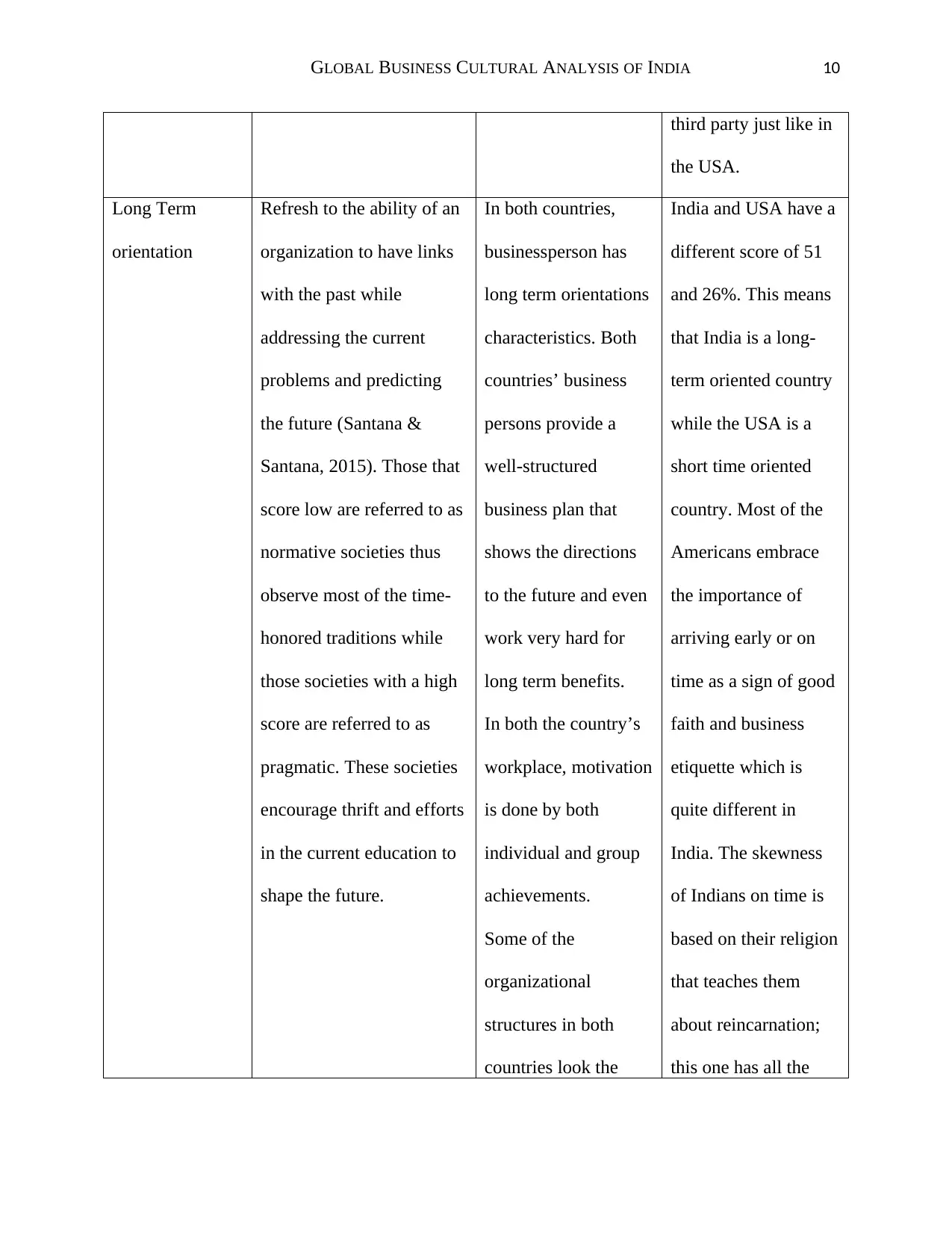
GLOBAL BUSINESS CULTURAL ANALYSIS OF INDIA 10
third party just like in
the USA.
Long Term
orientation
Refresh to the ability of an
organization to have links
with the past while
addressing the current
problems and predicting
the future (Santana &
Santana, 2015). Those that
score low are referred to as
normative societies thus
observe most of the time-
honored traditions while
those societies with a high
score are referred to as
pragmatic. These societies
encourage thrift and efforts
in the current education to
shape the future.
In both countries,
businessperson has
long term orientations
characteristics. Both
countries’ business
persons provide a
well-structured
business plan that
shows the directions
to the future and even
work very hard for
long term benefits.
In both the country’s
workplace, motivation
is done by both
individual and group
achievements.
Some of the
organizational
structures in both
countries look the
India and USA have a
different score of 51
and 26%. This means
that India is a long-
term oriented country
while the USA is a
short time oriented
country. Most of the
Americans embrace
the importance of
arriving early or on
time as a sign of good
faith and business
etiquette which is
quite different in
India. The skewness
of Indians on time is
based on their religion
that teaches them
about reincarnation;
this one has all the
third party just like in
the USA.
Long Term
orientation
Refresh to the ability of an
organization to have links
with the past while
addressing the current
problems and predicting
the future (Santana &
Santana, 2015). Those that
score low are referred to as
normative societies thus
observe most of the time-
honored traditions while
those societies with a high
score are referred to as
pragmatic. These societies
encourage thrift and efforts
in the current education to
shape the future.
In both countries,
businessperson has
long term orientations
characteristics. Both
countries’ business
persons provide a
well-structured
business plan that
shows the directions
to the future and even
work very hard for
long term benefits.
In both the country’s
workplace, motivation
is done by both
individual and group
achievements.
Some of the
organizational
structures in both
countries look the
India and USA have a
different score of 51
and 26%. This means
that India is a long-
term oriented country
while the USA is a
short time oriented
country. Most of the
Americans embrace
the importance of
arriving early or on
time as a sign of good
faith and business
etiquette which is
quite different in
India. The skewness
of Indians on time is
based on their religion
that teaches them
about reincarnation;
this one has all the
Paraphrase This Document
Need a fresh take? Get an instant paraphrase of this document with our AI Paraphraser
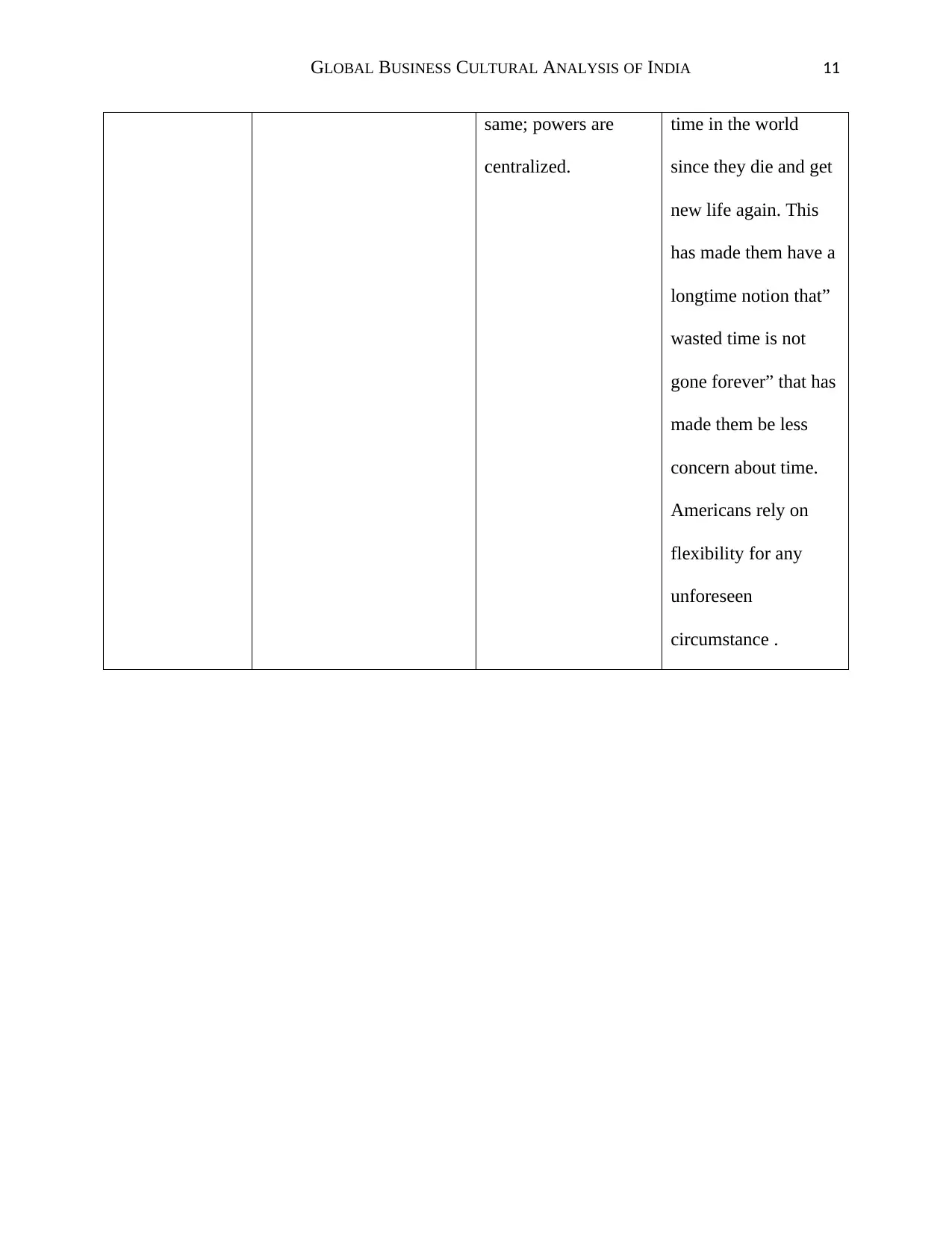
GLOBAL BUSINESS CULTURAL ANALYSIS OF INDIA 11
same; powers are
centralized.
time in the world
since they die and get
new life again. This
has made them have a
longtime notion that”
wasted time is not
gone forever” that has
made them be less
concern about time.
Americans rely on
flexibility for any
unforeseen
circumstance .
same; powers are
centralized.
time in the world
since they die and get
new life again. This
has made them have a
longtime notion that”
wasted time is not
gone forever” that has
made them be less
concern about time.
Americans rely on
flexibility for any
unforeseen
circumstance .
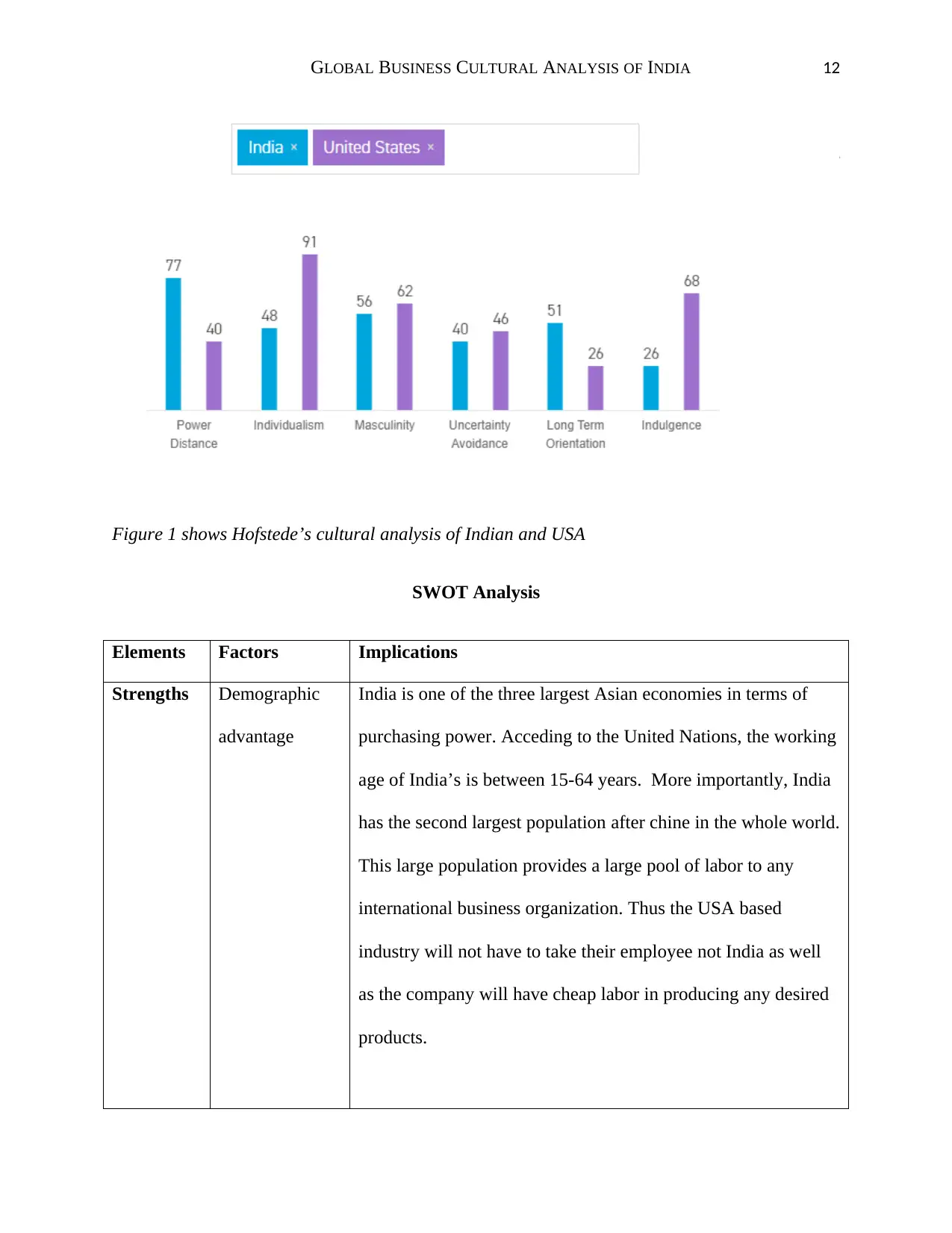
GLOBAL BUSINESS CULTURAL ANALYSIS OF INDIA 12
Figure 1 shows Hofstede’s cultural analysis of Indian and USA
SWOT Analysis
Elements Factors Implications
Strengths Demographic
advantage
India is one of the three largest Asian economies in terms of
purchasing power. Acceding to the United Nations, the working
age of India’s is between 15-64 years. More importantly, India
has the second largest population after chine in the whole world.
This large population provides a large pool of labor to any
international business organization. Thus the USA based
industry will not have to take their employee not India as well
as the company will have cheap labor in producing any desired
products.
Figure 1 shows Hofstede’s cultural analysis of Indian and USA
SWOT Analysis
Elements Factors Implications
Strengths Demographic
advantage
India is one of the three largest Asian economies in terms of
purchasing power. Acceding to the United Nations, the working
age of India’s is between 15-64 years. More importantly, India
has the second largest population after chine in the whole world.
This large population provides a large pool of labor to any
international business organization. Thus the USA based
industry will not have to take their employee not India as well
as the company will have cheap labor in producing any desired
products.
⊘ This is a preview!⊘
Do you want full access?
Subscribe today to unlock all pages.

Trusted by 1+ million students worldwide
1 out of 23
Related Documents
Your All-in-One AI-Powered Toolkit for Academic Success.
+13062052269
info@desklib.com
Available 24*7 on WhatsApp / Email
![[object Object]](/_next/static/media/star-bottom.7253800d.svg)
Unlock your academic potential
Copyright © 2020–2025 A2Z Services. All Rights Reserved. Developed and managed by ZUCOL.




